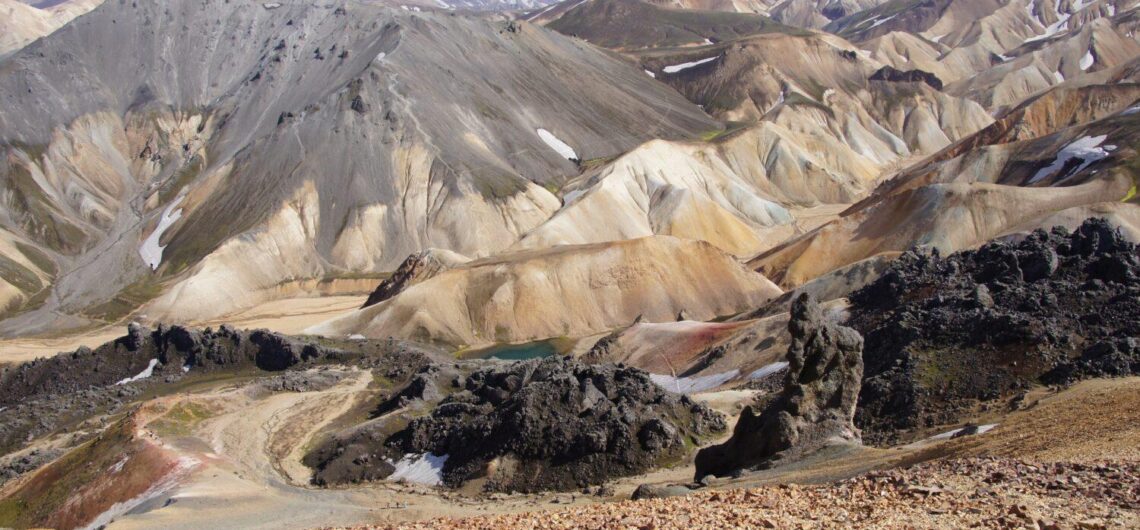Central Highlands cover most parts of the island, which is not inhabited and is categorized as a “desert.” The highlands can be harsh in weather, but some of Iceland’s most stunning spots are found in this region. The terrain can be difficult to navigate; even in summer, F-roads are only available for SUVs. But the increased difficulty level means that the places you visit will be just for you, as few tourists reach the highlands.
Most of Iceland’s glaciers are located in the mountains, and you can find magnificent volcanoes, black deserts, glacial rivers and waterfalls, geothermal zones, and hot pools in the area. Most highland areas also have amazing hiking trails. The highlands occupy most of Iceland, and you will most likely not explore the entire area while in Iceland. You will need to carefully plan your time and explore which parts of the highlands are most attractive to you.
There are almost no hotels in this region, so do not expect to book accommodation through a regular booking site. If you have not set up camp, you will have to stop at mountain huts that you can find in the area. Due to the high altitude, the temperature in the highlands is lower than in the lowlands. The temperature difference can be significant, so don’t assume that your highland adventure will experience the same weather conditions as Reykjavik. Temperatures at high altitudes rarely rise above 10 ° C / 50 ° F. It is also often windy there, so dress appropriately.
Be sure to visit Landmannalaugar if you love to travel, Kerlingarfjoll if you like geology, and Askja/Viti if dark and mysterious places arouse your curiosity.
Landmannalaugar
Landmannalaugar is a magnificent place known for its colorful landscapes and geothermal activity. Landmannalaugar is the starting point for hiking on the Laugavegur trail, the most famous multi-day hiking trail in Iceland. Because of this, there may be more visitors here, as well as in other highlands. Landmannalaugar’s attraction, besides the breathtaking scenery, is the small warm geothermal pool, which is ideal for swimming. There are no pool facilities, but most people don’t worry and get undressed on the pool terrace. Landmannalaugar is the perfect day trip destination from Reykjavik for those looking to explore Iceland’s Central Highlands.
Thorsmork
Thorsmork is a mountain range located in the south of Iceland. The name translates as “forests of Þór,” which refers to the Scandinavian god Thor. Thorsmork is a lovely place, combining Icelandic highlands, black sands, and dense forests. Thorsmork is also a tourist paradise. There are many hiking trails in the area, including the world-famous Laugavegur hiking trail. It is also the ending point (or starting point if you are heading north-south) of the Fimmvorðuhals route if you are interested in a day hike in the southern part of the central highlands.
Kerlingarfjoll
Kerlingarfjoll is a rhyolite caldera complex in the highlands of Iceland, close to the Kjolur highland route. As it is a geologically active area, it is surrounded by active volcanoes and natural geothermal pools. Apart from geothermal activity, the most striking characteristic of Kerlingarfjoll is its colorfulness. The reddish surface is associated with volcanic minerals. There are many hiking trails in the Kerlingarfjoll area. The longest of these is the 47 km/30 miles circle trail that leads around Kerlingarfjol. There are huts along the way, so you don’t need to camp if you don’t want to. Other hiking trails are shorter and can be done in just one day.
Askja and Viti
Askja is a series of calderas located remotely in the highlands north of the Vatnajokull Glacier. The calderas are part of a larger volcanic complex called the Dyngjufjoll Mountains. Askja’s most notable feature is the deep blue lake in the center of the caldera. The lake, called Oskjuvatn, is the deepest in Iceland. It was formed as a result of the last eruption of the Askja volcano in 1875.
Askja and the surrounding Dyngjufjoll Mountains are, without doubt, some of the most spectacular places in Iceland. Víti, one of the Askja calderas, is an explosive crater filled with geothermal water with high sulfur content. Although it is dangerously hot in some places, the Víti pool is popular with swimmers. The area is very remote from the main road and not very accessible. If you have a 4×4 car, you can visit the area. Near Askja, there are several hiking trails for the prepared hiker.
Hveravellir
Hveravellir is a magnificent geothermal area in the highlands. Gorgeous colors, hot springs, and a geothermal pool are what attract most of Hveravellir’s visitors. Many of those who visit the area hike along the Kjalvegur trail, which starts at Hveravellir and ends at Hvitarvatn. There is a campsite and several huts in the area, so accommodation should not be a problem if you want to spend a few days in Hveravellir. If you are on the Kjolur route, Hveravellir is also a good stopover.
Hekla
Hekla is one of the most mysterious volcanoes in Iceland and also the most active. Hekla last erupted in 2000, and since it usually erupts every fifteen years, the next eruption can be expected. Hekla is a volcano often associated with myths, superstitions, and magic. Hekla is a 1,419 m (4,892 ft) high strato-volcano that inspired people in the Medieval Ages. Hekla is not one of Iceland’s most popular hiking mountains. The weather conditions are usually severe near the summit and the road to the foot of the mountain. Hekla is rough and not suitable for all cars. Hekla’s volcanic activity can also scare off some tourists.

